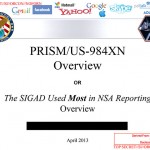For news hounds and conspiracy theorists alike, the past few days have been about as good as it gets.
A series of groundbreaking news stories, one published by the British paper The Guardian, the second by the The Guardian and the Washington Post, uncovered two top-secret U.S. government surveillance programs run by the National Security Agency, both aimed at collecting massive amounts of personal communications data. The findings have reignited the age-old debate over privacy and security. Civil libertarians - an interesting mix of key outspoken conservatives and liberals (yes, Rand Paul, Al Gore, and the ACLU are on the same page on this one) - expressed outrage over privacy invasions and government overreach, while President Barack Obama and a similarly unique blend of conservative and liberal government officials are defending the programs as a "critical tool" for rooting out potential terrorist activity and protecting American lives.
“You can’t have 100 percent security and also then have 100 percent privacy and zero inconvenience," Obama told reporters on Friday. "We’re going to have to make some choices as a society.”
If you're still a bit fuzzy on this week's whirlwind of James Bond-esque (or, some would say, Orwellian) developments, here are a handful of good resources to help make sense of it all.
Understanding and comparing the two surveillance programs
 The New York Times has a clear side-by-side comparison of the two programs, who they target, what data is collected and the companies involved in delivering it.
The New York Times has a clear side-by-side comparison of the two programs, who they target, what data is collected and the companies involved in delivering it.


